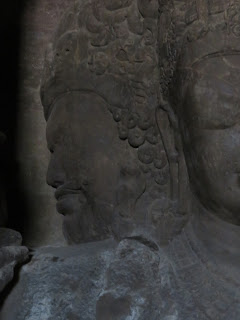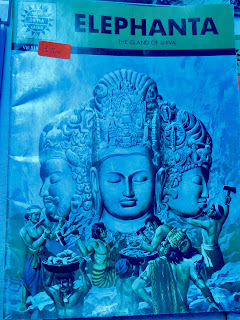Day 107 Sun Apr 30, 2023 Mumbai, India
Elephanta Caves (MUM-002) or do a FERRY from the Gateway of India taking an hour each way. 9:00 first ferry - 2:00 last ferry
April 30, 2023
Port: Mumbai
Tour Description
Discover the collection of Hindu shrines carved in the Elephanta Caves in the 7th century.
Hear the history of the Elephanta Caves and their significance to Hindus.
Learn how the caves became a World Heritage site as a perfect expression of Indian art.
Explore the extraordinary caves carved out of solid basalt rock on Gharapuri Island, which is considered the heavenly mountain residence of Lord Shiva. After cruising to the island, you will follow a stepped path to the Elephanta Caves, which hold a collection of shrines, courtyards and grand halls filled with exquisite stone sculptures and reliefs of Hindu gods and goddesses. All of them were carved in the 6th century, a feat so spectacular that UNESCO has deemed the caves a World Heritage site. The Portuguese, who ruled this area for about 200 years starting in the 16th century, named the island Elephanta for a large stone elephant statue found near the shore. Unfortunately, the Portuguese destroyed many of the sacred statues inside by using them for target practice. Even so, the sublime beauty of the caves remains and they still resonate with spiritual energy.
HELPFUL HINTS Dress in weather-appropriate clothing.
Wear flat comfortable walking shoes.
PLEASE NOTE This tour includes a short walk and climbing numerous steps. Although palanquins or sedan chairs are available at Elephanta Island, the cruise line doesn’t encourage or sanction their use.
It was nice to have a welcoming greeting after our rather complicated process of getting through immigration.
This mom was not sharing with her baby, she was busy eating herself.
This cow was getting up close and personal.
Sacred Cow.
The mom and her baby. We were warned that the monkeys will take your food that you are eating or your drink bottle if you are drinking.
Elephante Caves are a collection of five cave temples that date back to the 2nd century. They are a UNESCO site and are dedicated to the Hindu god Shiva. Inside are rock cut stone sculptures that were carved from solid basalt rock. The caves show a synchronicity of Hindu and Buddhist ideas. The monuments were defaced and damaged but an attempt to restore occured in the 1970s. The monuments are still very damaged. I appreciated our guide explaining the monuments.
We took a ferry from the Gateway of India and then climbed 120 steep steps from the beach on a very hot and humid day. Our first glimpse was of four pillars with three open porticoes. Stone columns support concealed beams. There are interior walls but no exterior wall. The construction allows air flow and natural lighting.
The first panel was Shiva as Yogishvara, Mahayogi demonstrating how yoga and meditation leads to the realization of ultimate reality. Shiva is surrounded by gods, goddesses, monks and sadhus who hold him in reverence as he is seated in his meditation. (See below)
Nataraja, Lord of Dance, cosmic dancer, or Nrittamurti is on the opposite portico. The panel is badly damaged. His position is lalita mudra symbolising space occupied, soaring energy and weightlessness. His face portrays preseving and sustaining all creation, all creative activity. A few gods and goddesses are visibly spellbound. Shiva’s sons illustrate family life. (See above)
Shiva slaying Andhaka illustrates the Andhakasura-vadha legend. Shiva/Bhairava/Virbhadra is a ferocious form killing the demon Andhaka. Shiva appears to be coming out of the rock impaling Andhaka with his trident with a facial expression of anger. The bowl was used to catch the blood of the demon because the blood had the power to to become new demons if they were nourished by the ground. The uppermost part shows flying apsaras (nymph or fairy) bringing garlands. (See below)
Shiva slaying Andhaka
Sadashiva/Trimurti is the most important sculpture showing a three-headed Shiva representing creation, protection and destruction. The central face looks like the preserver Vishnu representing compassion and wisdom. To the left, is the terrifying Aghora/Bhairava representing the chaos creator and destroyer. On the right, shows the promise of life and creativity. This face is a symbol for Brahma.
Brahma
Aghora/Bhairava
Ardhanarishvara represents the interdepencence of feminine and masculine aspects, fused divinity. Half Shiva and half Parvati, they have unified the energy and power and it is inseparable with the soul and awareness. There are humans, gods/goddesses and fairies surrounding the androgenous figure. Male is to the left with hand on bull and female is to the right.
Ravana shaking mountain, read below.
Many stalls lined the stone step walkway to the Elephant Caves.
It was very hot and incredibly crowded. There was a cricket match in town that brought the crowds and it was Sunday.


























No comments:
Post a Comment